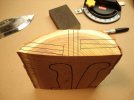- Joined
- Sep 14, 2006
- Messages
- 4,409
Wow, Andy, I am very impressed. Both with the project, and the review. Great work.
Currently I have removed the scales of mine. I found the tang to be canted at least 5 degrees off from the center line of the blade. I'm trying to figure out how to handle that issue now. Your project is a big help!!!
I haven't decided the scale material either. Hmmmm.
The tang on mine was straight (in line with the blade) but uneven, with a bit of a taper, so I got lucky.
I guess you could just clamp it in a vice and, well, push. Good luck with that!
Andy

